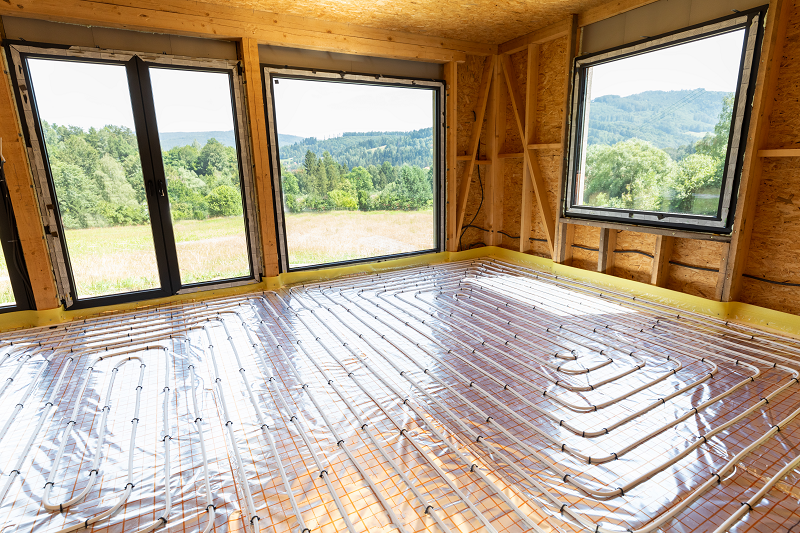
An In-Depth Guide to Radiant Floor Heating Systems: Types, Benefits, and Installation Considerations
Jonathan Ching
As homeowners seek more comfortable, energy-efficient, and eco-friendly heating solutions, radiant floor heating has emerged as a popular alternative to traditional forced-air systems. Radiant floor heating systems provide consistent warmth and comfort by distributing heat through the floor surface, creating an even temperature throughout your living space.
With its inherent energy-saving properties and minimal maintenance requirements, radiant floor heating is an excellent option for those looking to improve their home's heating efficiency, reduce energy bills, and create a more comfortable living environment. In this comprehensive guide, we'll explore the benefits of radiant floor heating, delve into the various types of systems and installation methods, and offer expert tips for selecting the ideal radiant heating solution for your home.
Radiant floor heating systems work by transferring heat from a warm surface (such as heated water pipes or electric cables installed beneath the floor) to the surrounding environment through conduction, convection, and radiation. This results in a more gradual, even distribution of warmth that eliminates cold spots and draftiness common in traditional forced-air heating systems. Additionally, radiant floor heating operates at a lower overall temperature, making it more energy-efficient and cost-effective than its counterparts.
Benefits of Radiant Floor Heating Systems
Choosing a radiant floor heating system for your home offers several significant advantages, including:
1. Enhanced Comfort: Radiant heating provides consistent, even warmth that eliminates cold spots and draftiness, creating a more comfortable living environment throughout your home.
2. Improved Energy Efficiency: Radiant floor heating systems operate at lower temperatures than traditional forced-air systems, reducing energy consumption and saving homeowners on utility bills.
3. Reduced Allergens and Dust: Unlike forced-air systems that can circulate dust particles and allergens, radiant heating systems help maintain better indoor air quality by not blowing air around.
4. Low Maintenance: Radiant floor heating systems have fewer moving parts than traditional HVAC systems, resulting in lower maintenance requirements and increased longevity.
Types of Radiant Floor Heating Systems
There are three primary types of radiant floor heating systems to consider when selecting the best option for your home:
1. Hydronic Systems: Hydronic radiant floor heating uses heated water circulated through a series of tubing installed beneath the flooring. This type of system is energy-efficient and considered the most popular choice for whole-house radiant heating installations.
2. Electric Systems: Electric radiant heating relies on electric cables or mats installed beneath the floor to generate heat. While these systems can be more costly to operate than hydronic systems, they are easier to install and ideal for smaller spaces, such as bathrooms or kitchens.
3. Air-Heated Systems: Air-heated radiant flooring systems use heated air circulated through tubing beneath the floor. However, these systems are not as energy-efficient as hydronic or electric systems and are less common in residential applications.
Installation Methods and Factors to Consider
When installing a radiant floor heating system, it's important to evaluate the various installation methods and consider critical factors that may affect the efficiency and compatibility of the chosen system.
1. Wet Installation: This method involves embedding the radiant heating tubes or cables within a layer of concrete or screed beneath the floor. Waterproof insulation is installed beneath the tubes to ensure that heat is directed upwards towards the living space. Wet installations provide excellent thermal mass, retaining and evenly distributing heat throughout the space.
2. Dry Installation: In a dry installation, the radiant heating tubes or cables are placed directly beneath the floor covering, often using specially designed panels, without the need for a layer of concrete or screed. Dry installations are quicker and easier than wet installations but provide less thermal mass, which may result in reduced energy efficiency.
Some factors to bear in mind when selecting and installing a radiant floor heating system include:
1. Floor Coverings: Different floor coverings have varying levels of thermal conductivity, which can affect the efficiency of your radiant heating system. Tile and stone floors are excellent conductors of heat, while carpets with thick padding may inhibit heat transfer.
2. Insulation: Proper insulation below the radiant heating system is essential to prevent heat loss and maximize efficiency. Inadequate insulation can lead to increased energy consumption and reduced performance.
3. Existing HVAC Systems: If you're installing a radiant floor heating system in an existing home, it's important to consider how it will integrate with your current HVAC system. Consult with a professional HVAC technician to assess compatibility and address any potential issues.
4. Budget and Space Considerations: Evaluate the costs, energy efficiency, and compatibility of different radiant floor heating systems to determine the best option for your budget and space requirements.
Conclusion
Radiant floor heating systems offer an energy-efficient and comfortable alternative to traditional forced-air heating, providing even warmth while reducing allergens and dust circulation. By understanding the types of radiant heating systems, installation methods, and factors to consider, homeowners can make informed decisions and choose the ideal heating solution to enhance their home's comfort and efficiency.
Whether you opt for a hydronic, electric, or air-heated system, radiant floor heating is an excellent investment for a more comfortable, sustainable, and energy-efficient home. Explore the world of radiant floor heating through the website of My Jockey, and discover the ideal heating solution for your home today!
